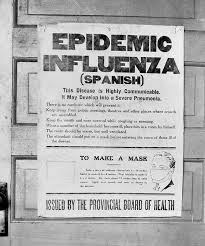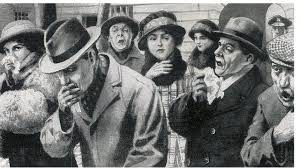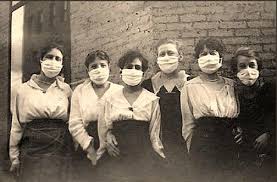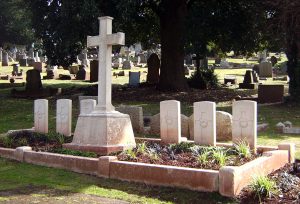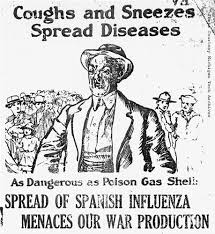At nine o’clock on the morning of 18th May, 1918, David Clammy died in Lanark’s Lockhart Hospital in Scotland. He was only 15 years old. While it is always sad when someone so young passes away, his death had an extra significance in that he was the first British victim of Spanish Flu, a pandemic that swept through many countries, with a further 228,000 lives lost in the United Kingdom alone. This, out of a total of over 40 million, although some estimates put the figure as high as twice that, roughly five per cent of the world’s population back then. The source of the outbreak has never been absolutely established other than it was not in Spain, as while many Spaniards did die from La Grippe Espagnole, the name was a misnomer, courtesy of some clumsy wartime censorship by their French neighbours over the Pyrenees. It probably originated in Northern China in late 1917, from where came 140,000 Chinese labourers, recruited by the British and French governments to help their cause in World War One (1914-18). It has also been suggested that it came from a US Army camp in Funston, Kansas, and was brought over to Europe by American soldiers, that case strengthened by the fact that half of their fatalities in WWI were from the flu and not on the battlefield.
Spanish Flu arrived in Torbay in the July of 1918, affecting Brixham first, where 25 locals perished, most being women aged 25-45. The port’s medical officer reported that, “There were a lot of people running around with the Spanish Flu epidemic,” and blaming females,” going around with bare chests and other eccentricities of fashion.”
Torquay suffered more from October to the end of the year when there were 72 deaths from the disease. The health authorities stated that the flu was an unusual type, “The onset being quickly followed by a toxic form of pneumonia, which was little affected by treatment and rapidly proved fatal. Strong robust individuals and pregnant women nearing the end of their confinement were common victims. In the latter abortion took place, quickly followed by death.”
Typical of those who succumbed to Spanish Flu in Torquay were a Dorothy Handford, aged 33, of Vernon Court in Warren Road; Elise Mellhuish, from St Marychurch, also 33, and Gladys Watts, another St Marychurch resident (26). Daisy Cole, who lived in St Edmunds Road, was only 18, while Frederick Davis of Vansittart Road was just a year older. And Dorothy White (26) of the Hole in the Wall pub and John Bennett (34), who lived across the lane in the Devon Arms, died within two weeks of one another. Another to perish was 16 year old Georgina Ayshford, an ex-Cockington School pupil who had lived in Walnut Road. And the Torquay Directory newspaper of 26th February, 1919, ran the headline: ‘Chelston Boy’s Sudden Death’, over the story of the demise of Harold Hannaford, aged 9, of Mallock Road, in which Dr Alan Bennett reported that, “The body showed signs of pleurisy and bronchial pneumonia. The suddenness of death is characteristic of the type of influenza prevalent just now.” Several New Zealand servicemen billeted in the town also died of the flu and they have their own memorial in Torquay Cemetery (pictured below). Perhaps almost to be expected, the highest number of deaths from the disease occurring in Paignton were of American soldiers at the Oldway War Hospital, where in only two weeks a hundred of them died. They were buried in a mass grave in Paignton Cemetery but then exhumed in 1920 and taken back to the USA for reburial.
Life in Torbay was severely disrupted over this period as schools, churches, theatres, dance halls and other public places were shut down. Dymond and White’s Chronology of Torquay recorded that, “During the first week of November (1918) the influenza epidemic was reported to have assumed rather serious proportions in and around Torquay, and several functions were postponed on this account.” The Torquay Times of 23rd October, 1918, had a small piece entitled, ‘How influenza may be avoided,’ but this was dwarfed by advertisements for Bird’s Egg Substitute and Hall’s Wines. And weeks later there appeared an announcement headed, ‘Influenza, An Apology for the Shortage of Bovril,’ followed by an explanation as to why that splendid beverage was in such short supply. Commerce will out.
By 1920 the Spanish Flu epidemic had subsided but only after it had left behind a trail of death and distress in its wake, made all the more devastating as it had come during a war that had already claimed millions of young lives. Today most countries would be expected to cope a lot better in the circumstances, but individuals should also keep an eye on their own well-being if they are able. That is why I will be off to my local surgery again this winter for the usual flu jab as it could well save a lot of discomfort in the long run. See you there.
(With thanks to other members of the Torquay Library History Club for unearthing some of the above details during research for our Spanish Flu Anniversary Project)

You can join us on our social media pages, follow us on Facebook or Twitter and keep up to date with whats going on in South Devon.
Got a news story, blog or press release that you’d like to share or want to advertise with us? Contact us


